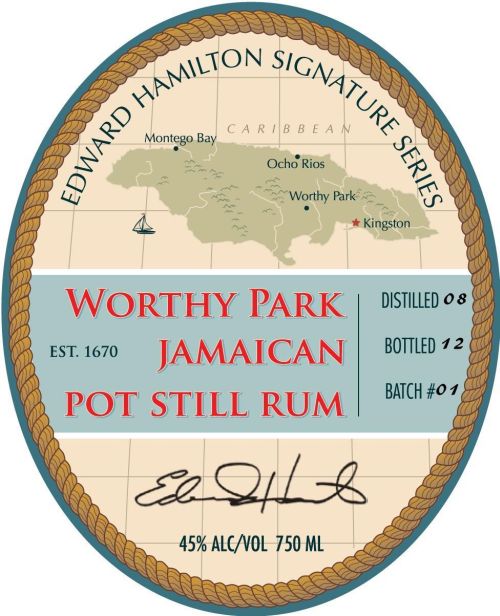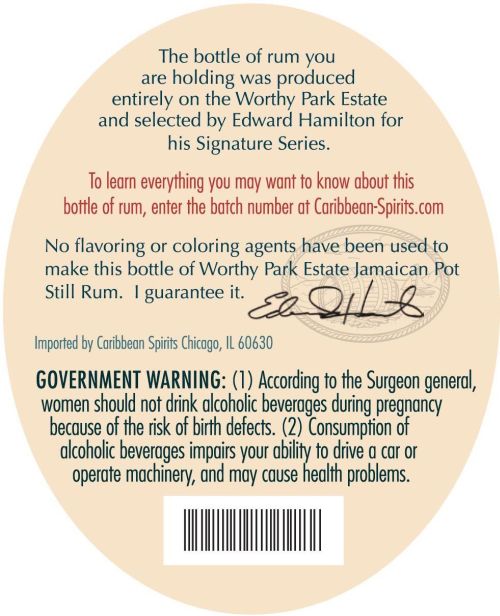But it happens. Or so it appears. Let's briefly review some history...
1. Hamilton announced his own rums in late 2011. Soon thereafter he actually applied for and got approval for a very specific label....
 ...
...
https://www.ttbonline.gov/colasonline/v ... 9001000224
Please note that this Jamaican Rum from Worthy Park was to be 90 proof and note this well: "No flavoring or coloring agents... I guarantee it!"! Really?
2. He also promised to be quite transparent and make available far more information than is typical, and to include:
Raw Material
Fermentation ABV
Date Distilled
Distillation ABV
Barrel Number
Date Barrel Filled
Barrel Volume
Barrel ABV
Date Barrel Emptied
Barrel ABV
Impressive. But did he actually provide these? Keep reading.
3. But just months later, he announced yet a different rum - the current Jamaican Pot Stilled Black Rum - and this time admitted to using color, stating "...Those labels were for a previous rum that I wanted to import but that didn't happen. As for coloring, it will be sugar based caramel." Now that's a strange statement because the current rum is from the same Worthy Park, a new make white, unaged in wood and which happens to be made and delivered to Hamilton without color. It's Hamilton who adds the color, but not just any caramel coloring. Nope, to make up for adding color his new pitch was that the coloring he intended to use seemed to be Sethness' DS-400 - a double strength soft drink E-150d caramel coloring rarely used for high proof spirits . Strange? Sure it is, but was there method to his madness?
His new claim was that he'd chosen this unusual double strength coloring appeared to be: made from "Non-GMO Florida cane sugar". Double wow, yes? The tortured rationale:
"Hamilton: "For example, none of the sugar cane used to make the molasses that was fermented or caramel used to color the Jamaican rums came was genetically modified. Few American whisky distillers can say that for their American corn. But at this moment they don't have to admit using gmo corn because the public isn't asking about the source of the raw material. Does it matter? The Europeans and a lot of people around the world think so."
4. Only one problem. According to Sethness' website, DS-400 seems NOT to be marked as of their listed non-GMO colorings. Make what you will of that. But Hamilton claimed to have purchased 5 expensive gallons of it, and he'd stick to his claim of "Non-GMO coloring made from Florida sugar cane". Was it just too good a marketing bullet to abandon? Would the monkeys even notice or care?
5. Now mind you of the 9 pieces of data he'd promised, it appears that well less than half were actually provided. Oh well.
Russell in a fit of major butt kissing, accidentally reveals the truth...
Recently our man Dave decided to review both the Gold and Black and couldn't find a real difference, save one and I quote:
What! The Gold uses a "viscous, grease-like, less bitter caramel"?"There are two rums being reviewed here. Both the Black and Gold Hamilton Jamaican expressions use the same base rum; the difference between the bottled products is the speciifc type of caramel used for coloring. The Black rum uses a double strength, bitter black caramel that tastes like burnt electrical cord, whereas the Gold rum uses a viscous, grease-like, less bitter caramel. "
Dave seems pretty clear about this new, previously unannounced, unpromoted caramel of convenience. Surely Hamilton must have shared this with him. What was wrong with the DS-400? Too strong? Too dark? And what about the questionable "non-GMO" claim? Dave later dutifully repeated Hamilton's "non-GMO" sales bullet, but then didn't question him as to why the double-strength pop coloring wasn't used in the Gold? Was a proper E-150a used instead?
Flat Ass Bottom LIne
I have never known of any other rum that has been through so many changes and unusual if not dubious choices: from "free of coloring and flavorings" to double-strength soft drink coloring, to claiming that coloring is "non-GMO cane sugar based", to selling the same unaged new make as a "Gold" and as a "Black", to using another "less bitter" caramel, to data promised but not delivered, to a rum that according to Russell has "some of the most prolific legs of any rum I have ever sampled" (another subject).
Personally I'm very much a supporter of pot-stilled products, particularly from Jamaica and even a new make that's never seen wood. At roughly $25 though, that's awfully dear, especially in light of a truly uncolored and unflavored, 5-star, pot-still based overproof - Wray & Nephews - which sells for almost half the price. But that's Hamilton's problem. My real concern is when any small distillers or bottlers - who desperately seek distinguishing marketing points - turn to a claim that even if true (non-GMO sugar-based coloring) is meaningless. All caramel coloring is exceptionally bitter and used in drops - with no perceptible taste differences. What really bothers me is the very unusual use of an E150d-class color.
Unlike the almost standard E150a class - recommended by the Scotch Whisky Society, and which is simply plain caramel coloring - the d-class uses a special sulfite-ammonia process designed for acidic soft drinks. The d-class has a shorter shelf life (ie it will fade in longer held spirits), is not really recommended for high proof spirits, and worst of all is strongly suspected of being carcinogenic and thus is now strictly limited and regulated by law in California. Accordingly - Coca Cola and Pepsi Cola - who used to use 90% of the stuff - have changed to a less risky coloring. Didn't the promoter know this? Didn't he care? Was the marketing bullet that critical? Did he think this was not important, or would not become an issue?
You decide.
*******
BTW, the Russell review was one of the most glowing tributes to a man and a rum he'd obviously like to sail with. His score (for both as one and the same): 8. You can read it here:
http://www.rumgallery.com/hamilton-jama ... still.html

